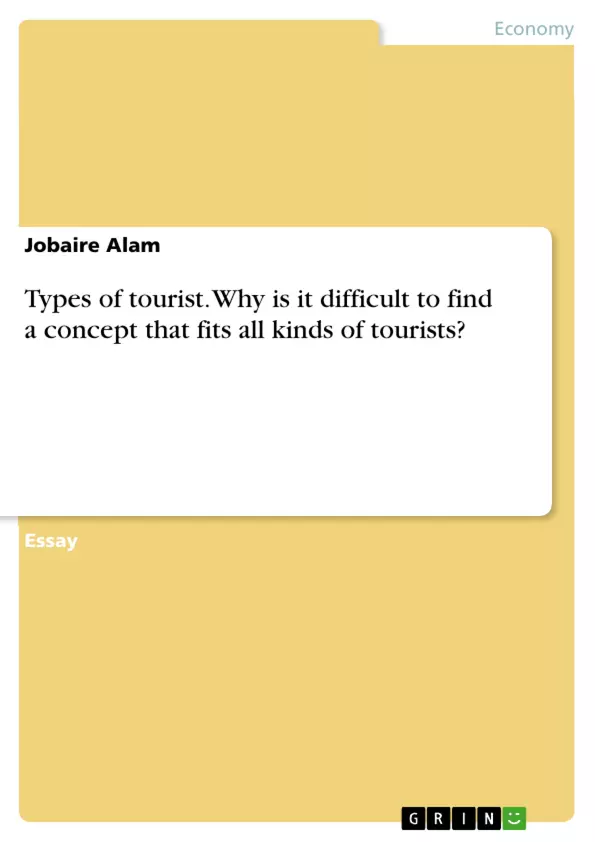The idea and the definition of tourist and tourism have been implicitly indicated in a particular article of Cohen, 1974. Tourism is just travelling or getting around for mental refreshment, leisure, recreation, business purposes etc. So, tourists can be defined by saying about the people who are travelling around and living moveable in the places, apart from their usual environment, for recreational, leisure, business activity and so on.
Table of Contents
- Tourist Types and Roles
- Types of Tourists
- Temporary Travelers
- Voluntary Travelers
- Round-Trippy Travelers
- Long Journey Category Tourists
- Non-Recurrence of a Trip
- Non-Instrumental Travelers
- Tourist Roles
- Permanency
- Voluntariness
- Direction
- Distance of the Trip
- Recurrence
- Purpose of Trip
Objectives and Key Themes
This paper aims to explore the concept of tourist types and roles as defined by Cohen (1974). It examines the criteria used to classify tourists and analyzes the various dimensions that differentiate various tourist experiences.
- Defining the Tourist and Tourism
- Classifying Tourists Based on Travel Characteristics
- Analyzing the Roles Tourists Adopt During Travel
- Exploring the Ambiguity in Defining Tourist Categories
- Contrasting Tourist Types and Roles
Chapter Summaries
Tourist Types and Roles: This section introduces the core concept of the paper, defining tourism and tourists based on Cohen's 1974 work. It sets the stage for a deeper exploration of the multifaceted nature of tourism by initially establishing the fundamental parameters of its definition, highlighting the ambiguities and complexities inherent in categorizing tourists and their travel experiences. The section introduces the key themes of temporariness, voluntariness, directionality of travel, distance covered, trip recurrence, and the purpose of travel, which are subsequently explored in greater detail.
Types of Tourists: This chapter delves into a detailed classification of tourist types according to the criteria established in the introduction. Each type is meticulously examined, highlighting specific characteristics and contrasting them with other categories. The author emphasizes the blurry lines between categories, acknowledging the difficulties in establishing strict boundaries due to the varied contexts and individual experiences of travelers. Examples are given to illustrate the nuances within each type, clarifying the complexities of the classification system and demonstrating how different factors such as cultural norms and individual circumstances can influence the categorisation of a tourist.
Tourist Roles: This chapter shifts the focus from the characteristics of the trip to the roles assumed by tourists. It explores the dimensions of permanency, voluntariness, direction of travel, distance, recurrence, and purpose, examining how these aspects contribute to the overall tourist experience. The chapter highlights the variability within each dimension, explaining how situational factors affect the classification and highlighting the inherent fuzziness in defining specific roles. The discussion uses real-world examples to clarify the application of these dimensions, showing how the same traveler can embody different roles in different circumstances, demonstrating the dynamic and fluid nature of tourist roles.
Keywords
Tourism, tourist types, tourist roles, Cohen (1974), temporary travelers, voluntary travelers, round-trip, long journey, non-recurrence, non-instrumental, permanency, voluntariness, direction, distance, recurrence, purpose of trip, travel characteristics, classification, ambiguity.
Frequently Asked Questions: A Comprehensive Language Preview of Tourist Types and Roles
What is this document about?
This document provides a comprehensive preview of a paper exploring the concept of tourist types and roles, primarily based on Cohen's 1974 work. It includes a table of contents, objectives, key themes, chapter summaries, and keywords. The focus is on classifying tourists based on various travel characteristics and analyzing the roles tourists adopt during their journeys.
What are the main sections of the document?
The document is structured into four main sections: An "Inhaltsverzeichnis" (Table of Contents), outlining the structure; "Zielsetzung und Themenschwerpunkte" (Objectives and Key Themes), which explains the paper's goals and key concepts; "Zusammenfassung der Kapitel" (Chapter Summaries), providing overviews of each chapter; and "Schlüsselwörter" (Keywords), listing important terms used in the paper.
What are the key themes explored in the paper?
The key themes revolve around classifying tourists and their roles. These include defining the tourist and tourism itself, classifying tourists based on travel characteristics such as temporariness, voluntariness, direction of travel, distance, trip recurrence, and purpose of travel. The paper also explores the ambiguity inherent in defining tourist categories and contrasts tourist types with tourist roles.
How are tourist types classified?
The paper classifies tourist types based on several criteria, including whether the travel is temporary or permanent, voluntary or involuntary, the direction and distance of the trip, whether the trip is recurring, and the purpose of the trip. Specific types mentioned include temporary travelers, voluntary travelers, round-trip travelers, long journey category tourists, non-recurrence of a trip travelers, and non-instrumental travelers. The document emphasizes the often blurry lines between these categories.
How are tourist roles defined?
Tourist roles are analyzed based on dimensions such as permanency, voluntariness, direction of travel, distance, recurrence, and the purpose of the trip. The paper highlights that these dimensions are often fluid and that the same traveler can embody different roles depending on the circumstances of their travel.
What are the key differences between tourist types and tourist roles?
While both tourist types and roles contribute to understanding tourism, types focus on the characteristics of the trip itself (duration, purpose, etc.), while roles focus on the traveler's behavior and position within the tourism experience. The paper explores the interrelation and sometimes overlapping nature of these concepts.
What is the significance of Cohen (1974)?
Cohen's 1974 work serves as a foundational text for the paper's analysis of tourist types and roles. The paper builds upon and expands on Cohen's framework for understanding the complexities of tourism.
What are the keywords associated with this paper?
Keywords include: Tourism, tourist types, tourist roles, Cohen (1974), temporary travelers, voluntary travelers, round-trip, long journey, non-recurrence, non-instrumental, permanency, voluntariness, direction, distance, recurrence, purpose of trip, travel characteristics, classification, ambiguity.
- Citation du texte
- Jobaire Alam (Auteur), 2013, Types of tourist. Why is it difficult to find a concept that fits all kinds of tourists?, Munich, GRIN Verlag, https://www.grin.com/document/413357



